Situated on the U.S. east coast, North Carolina is a state known for its diverse landscapes and rich history. Its landscape, a rich tapestry woven with an array of terrains, spans from the towering Appalachian Mountains in the west to the lapping waves of the Atlantic Ocean in the east.
The rugged, majestic Appalachians define the western region of North Carolina. This mountainous terrain is home to the Great Smoky Mountains National Park and the Old North State’s highest point, Mount Mitchell. The elevations here rank among the highest in the eastern United States, offering breathtaking vistas and diverse ecosystems.
As the mountains give way to rolling hills, North Carolina’s Piedmont region unfolds. Characterized by its red clay soil, this part of the state hosts a mix of urban and suburban landscapes, including major cities like Charlotte and the vibrant Research Triangle of Raleigh, Durham, and Chapel Hill.
Eastward, the undulating Piedmont flattens into the Coastal Plain, a region marked by varied landscapes from dense pine forests to sprawling wetlands. The Coastal Plain, abundant in unique flora and fauna, also forms North Carolina’s agricultural heartland, with fields of tobacco, sweet potatoes, and soybeans blanketing the terrain.
Finally, the state’s geographical journey culminates in the east with the Atlantic Ocean. North Carolina’s coastline, with its expansive sandy beaches, tranquil barrier islands, and bustling coastal towns, forms an integral part of its geographical identity.
In this article, we discover North Carolina’s lowest point.
What Is the Lowest Point in North Carolina?
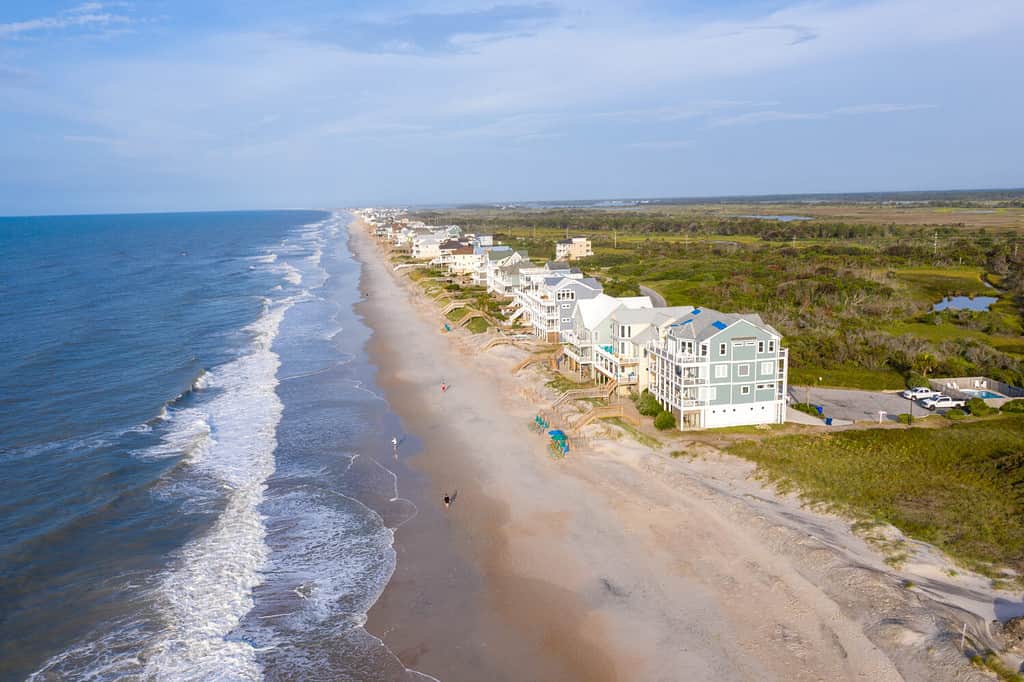
The coastline where the Atlantic Ocean meets North Carolina is the lowest geographical point in the state.
©MICHAEL HUBEL/Shutterstock.com
The Atlantic Ocean is the lowest point in North Carolina. More than just a geographical footnote, this vast body of water brims with stories, mysteries, and life.
Picture the Atlantic, its waves lapping North Carolina’s coastline, mirroring the sky with its ever-changing shades of blue. Its surface, at times, tranquil as a lake, and at others, powerful and untamed. Below the surface, an intricate world thrives, playing out an unending spectacle of nature’s drama.
But the Atlantic is more than just a spectacle; it’s an integral part of North Carolina. It shapes the state’s climate, drives its economy, and nourishes its rich biodiversity. It also etches memories in the hearts of residents and visitors alike, be it through a child’s first beach vacation, a thrilling surf ride, or the peaceful solitude of a sunrise walk.
History of the Atlantic Ocean: A Timeless Tale
Our journey through the Atlantic’s history starts about 200 million years ago, during the Late Triassic period. What we know today as the continents were all part of one giant landmass named Pangaea. Then, colossal geological forces initiated a slow yet relentless process of separation. The fracture lines started to fill with water, giving birth to the Atlantic Ocean.
The Age of Exploration: Charting New Waters
Fast-forward a few million years to the age of human history. The Atlantic Ocean played a crucial role in exploration and colonization. During the 15th and 16th centuries, the Atlantic became the stage for a world-changing drama. Brave explorers, most notably Christopher Columbus and Vasco da Gama, embarked on perilous voyages across this vast, unknown expanse. Their voyages bridged the Old and New Worlds, forever altering the course of human history.
The Atlantic Slave Trade: A Dark Chapter
Sadly, the Atlantic’s history has its dark chapters. From the 16th to 19th centuries, the Atlantic Ocean was the conduit for the transatlantic slave trade. Millions of Africans were forced across the ocean under inhumane conditions. This painful episode left a lasting impact on the demographics and societies on both sides of the Atlantic.
The Industrial Age: Shipping and Commerce
In the 19th and 20th centuries, the Atlantic became a bustling highway for international trade and travel. Transatlantic shipping lines carried goods, people, and ideas back and forth, facilitating economic growth and cultural exchange. Important passenger routes, like the one from Liverpool to New York, became iconic symbols of this era.
World Wars and the Atlantic Ocean

Many shipwrecks can be found all around the Atlantic.
©Kichigin/Shutterstock.com
The two World Wars of the 20th century also left their mark on the Atlantic. It was the site of naval battles, U-boat warfare, and convoy routes. Even today, remnants from this time, such as sunken warships, rest on the ocean floor, silent witnesses to the past.
The Modern Era: A Sea of Challenges and Opportunities
Today, the Atlantic Ocean continues to play a pivotal role in global affairs. It’s a hotbed for commercial fishing, a major route for shipping, a source of oil and gas, and a crucial topic in climate change discussions. Yet, it’s also facing serious challenges, like overfishing, pollution, and rising temperatures.
Fun Facts About the Atlantic Ocean: The Sea of Surprises
The Atlantic Ocean, a veritable cornucopia of curiosities, is more than just North Carolina’s lowest point. It’s a universe in itself, filled with wonders and mysteries. Let’s dive in and discover some fascinating facts about this dynamic and diverse ocean.
The Second Largest Ocean
The Atlantic Ocean comes in second on the podium of the world’s largest oceans. Encompassing a fifth of the Earth’s surface, the Atlantic Ocean stretches over an impressive expanse of around 41.1 million square miles. Its vastness could fit all of North America and Europe with room to spare!
It’s Continuously Growing

The Atlantic Ocean is massive and is growing more each year.
©Anna Moskvina/Shutterstock.com
Unlike most things in life, the Atlantic Ocean is getting bigger. Yes, you read that right! Due to tectonic activity, the Atlantic Ocean is expanding at an average rate of about 1 inch per year.
A Highway for Heat
The Atlantic Ocean acts as a gigantic conveyor belt transferring heat from the tropics to the poles. The Gulf Stream, recognized as a warm maritime current, significantly contributes to moderating the world’s climate by facilitating the global dispersion of heat.
The Longest Mountain Range
Beneath the Atlantic’s surface lies the longest mountain range in the world, the Mid-Atlantic Ridge. Stretching over 10,000 miles, this underwater mountain chain even surpasses the mighty Himalayas in length.
A Cache of Treasures
The Atlantic Ocean is a treasure trove, and we’re not just talking about pirate booty. It’s rich in resources, from vast reserves of oil and gas found beneath its floor to a bounty of fish species that sustain billions of people worldwide.
A Haven for Hurricanes
The Atlantic Ocean is also known as the birthplace of hurricanes. The warm waters of the Atlantic, particularly in the Caribbean Sea and the Gulf of Mexico, fuel the formation of these mighty storms.
An Array of Islands
The Atlantic is sprinkled with thousands of islands, from massive landmasses like Greenland, the largest island in the world, to tiny, unspoiled paradises like the remote Tristan da Cunha.
How Many People Visit the Atlantic Ocean Annually?
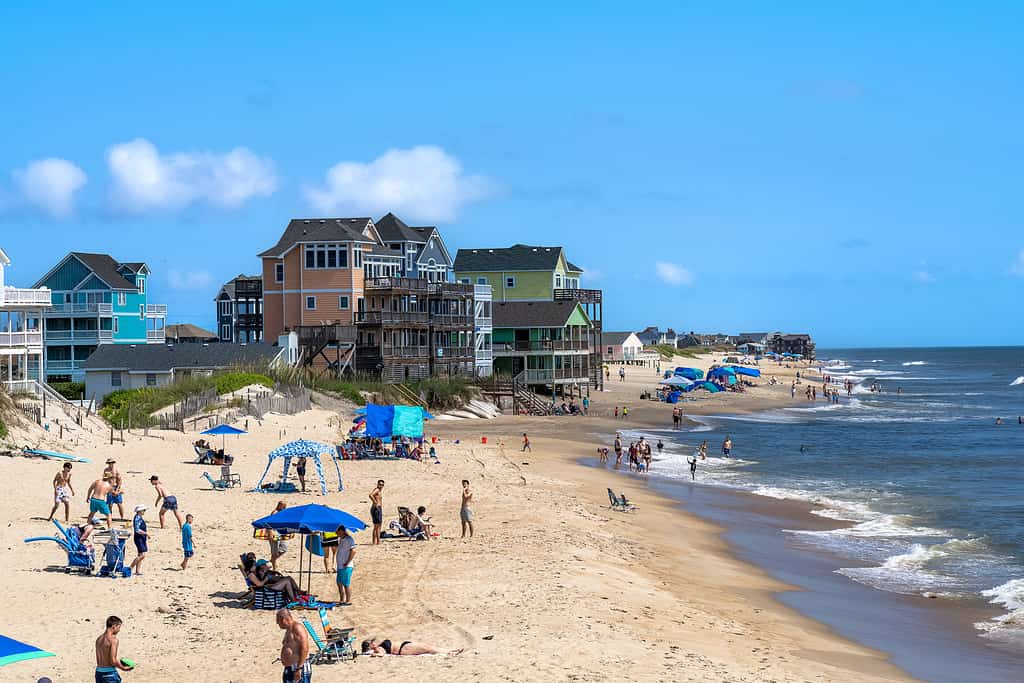
A view of people and vacation homes on the beach as seen from the Rodanthe Pier in Dare County, NC.
©iStock.com/Kyle Little
The Atlantic coast welcomes an estimated 15 million visitors annually—from sun-soaked beachgoers to history enthusiasts and nature lovers.
Seasonal Swing
Naturally, the number of visitors fluctuates throughout the year. Summer is the peak season, with visitors flocking to the coast from June through August. During this period, the visitor count can easily reach up to 10 million. However, the off-peak seasons of spring and fall are also popular, drawing in around 5 million visitors keen on enjoying the Atlantic’s beauty without the summer crowd.
Diverse Visitor Demographic
Visitors to the Atlantic coastline in North Carolina come from all walks of life. It’s a favorite spot for family vacations, drawing parents and kids with the promise of sandy beaches and fun-filled activities. Couples find it an ideal setting for a romantic getaway, while water sports and hiking trails lure adventurers.
What Makes the Atlantic Ocean a Special Place to Visit?
North Carolina’s lowest point, the Atlantic coast, is renowned for its beautiful beaches. Each has its own charm, from the grandeur of the Outer Banks, with its untamed beauty and iconic lighthouses, to the family-friendly sands of Carolina Beach. The unspoiled, dune-backed beaches are an idyllic setting for sunbathing, beachcombing, and coastal hikes.
A Nautical Playground
For water sports enthusiasts, the Atlantic coast is a dream come true. Surfing, kiteboarding, kayaking, paddleboarding—you name it, you can do it here. The warm Gulf Stream current creates ideal conditions for a variety of water activities. Plus, the area’s numerous shipwrecks make it a fantastic destination for scuba diving.
A Birder’s Paradise
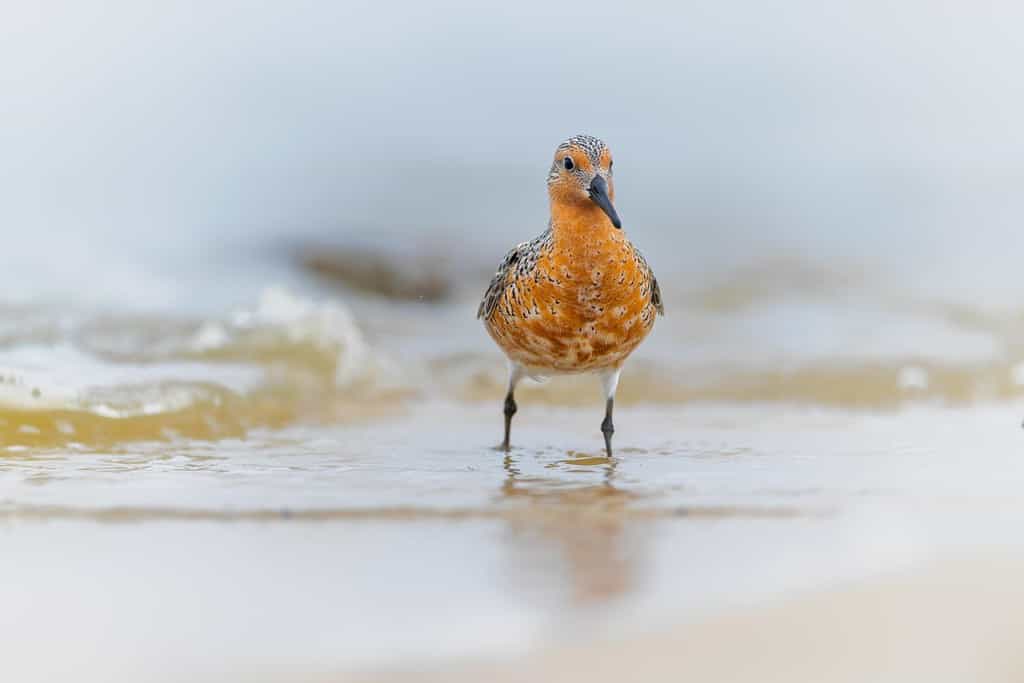
The red knot migrates from the southern tip of South America to the Arctic and back each year, generally visiting North Carolina in the spring.
©Buvana Bala/Shutterstock.com
Bird watchers are in for a treat too. The coastal region, particularly Cape Hatteras National Seashore, is a migratory route for many bird species. Visitors can spot everything from pelicans and ospreys to plovers and red knots.
A Seafood Lover’s Delight
If you’re a seafood lover, prepare for a culinary delight. Fresh catches of the day translate to a gastronomic adventure, with local specialties like clam chowder, shrimp and grits, and crab cakes that will make your taste buds sing.
An Artist’s Muse
For artists and photographers, the Atlantic coast offers endless inspiration. The blend of stunning sunrises over the ocean, wild horses roaming in Corolla, and historic lighthouses against the vast expanse of the sea are scenes straight out of a dream.
What Animals Live in the Atlantic Ocean?
North Carolina’s stretch of the Atlantic Ocean is a world of astonishing biodiversity. From the smallest plankton to the largest whale, this underwater realm teems with life. Let’s explore this fascinating marine menagerie.
Marine Mammals
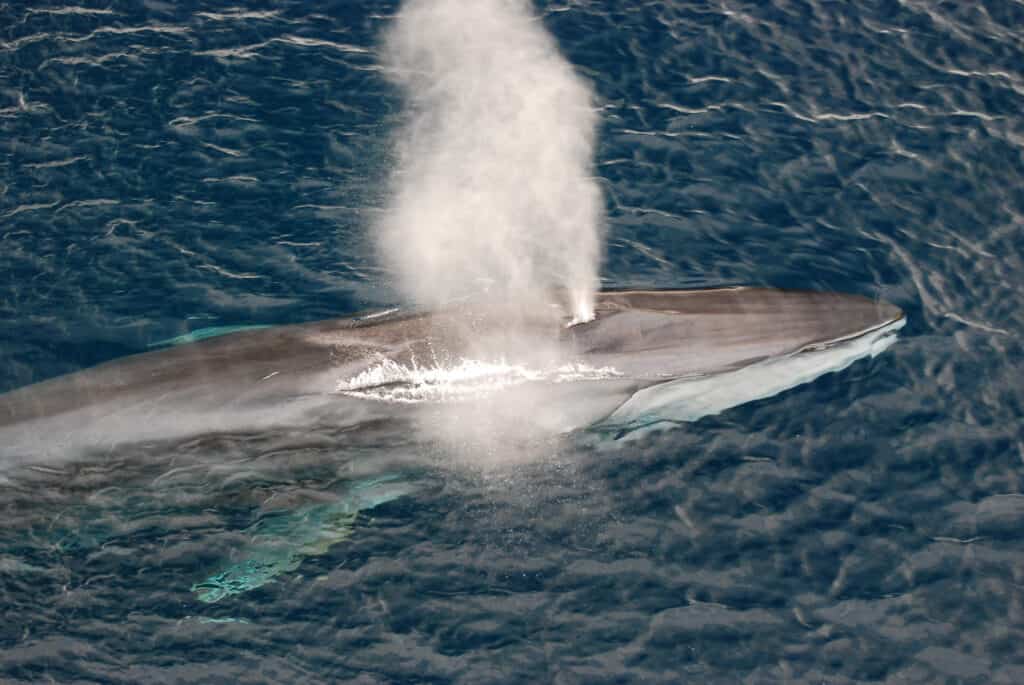
The fin whale is the second-largest whale species on earth, second only to the
blue whale
.
©iStock.com/JG1153
Often stealing the spotlight are marine mammals. Dolphins, like the common bottlenose, often delight beachgoers with their playful antics near the shore. Deeper out to sea, you might spot fin whales or the awe-inspiring humpbacks on their migratory routes.
Sea Turtles

Loggerheads are the most abundant species of sea turtle found in U.S. coastal waters.
©iStock.com/naturepics_li
Sea turtles also call the Atlantic Ocean home. The loggerhead, green, and leatherback turtles are just some species nesting on North Carolina’s beaches. Each summer, the beaches transform into vital nurseries where female turtles lay their eggs and baby turtles make their first journey into the ocean.
Seabirds
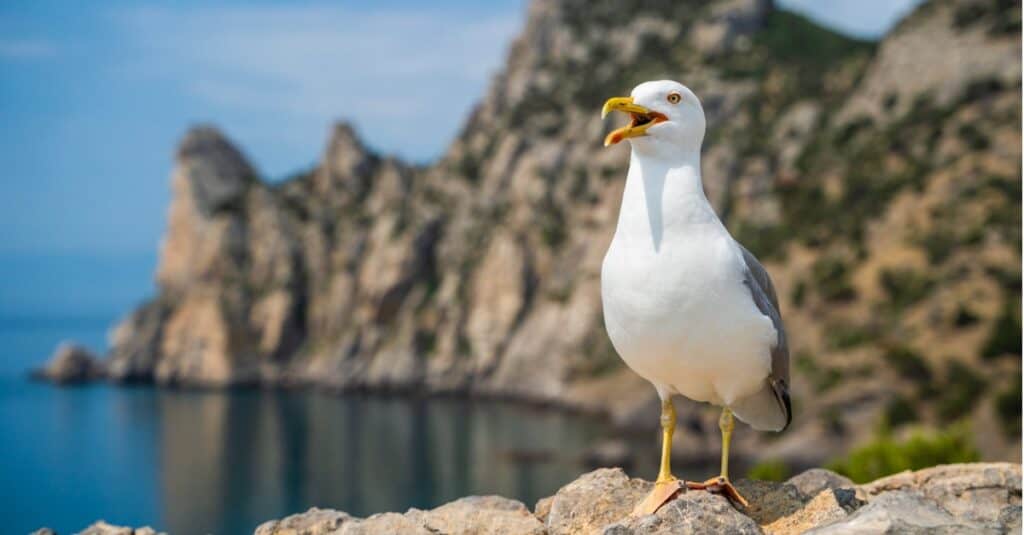
Gulls can be found all along the coastline of North Carolina.
©iStock.com/Evgenyi_Eg
Look up, and you’ll see another side of Atlantic’s animal life. Seabirds, like pelicans, terns, and gulls, fill the skies, diving into the waters to catch their prey. They often nest on the state’s barrier islands, making North Carolina essential for their life cycle.
Fish and Invertebrates
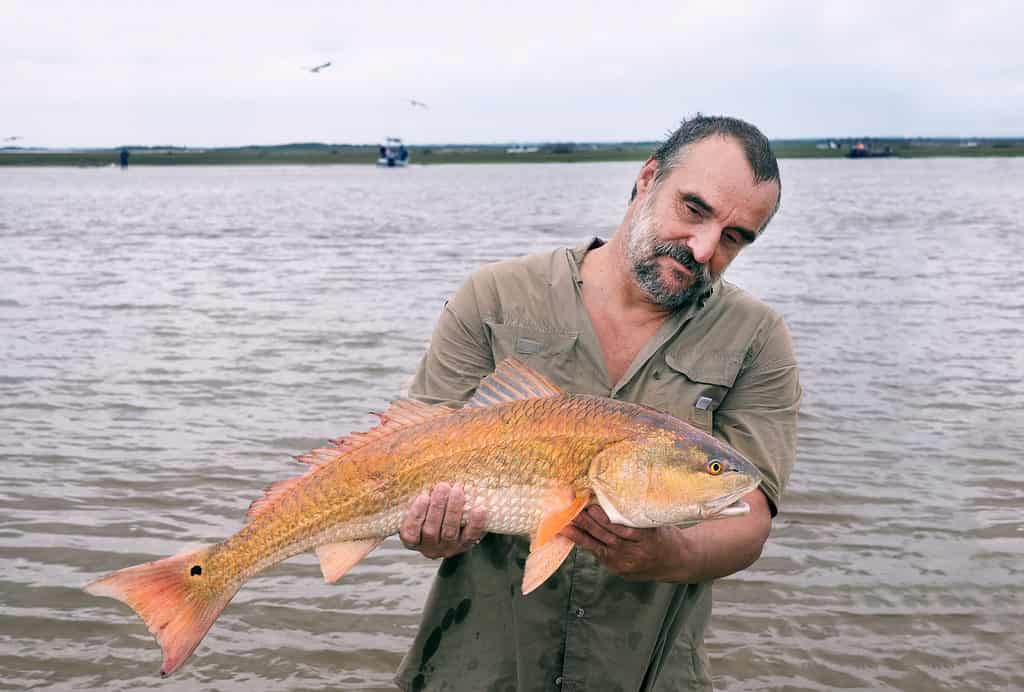
Red drums are carnivores who feed on crustaceans and small fish.
©IrinaK/Shutterstock.com
Under the waves, an incredible variety of fish dart among the currents. From groupers to mackerel to the state’s official saltwater fish, the red drum, the diversity is astounding. Let’s not forget about the invertebrates! Shrimp, crabs, clams, and countless species of starfish and seahorses create a colorful mosaic on the ocean floor.
Plankton
Finally, we must mention the ocean’s unsung heroes, the plankton. These tiny lifeforms serve as the foundational element of the oceanic food web. The phytoplankton also plays a crucial role in our planet’s oxygen production, giving us yet another reason to appreciate the Atlantic’s animal inhabitants.
Key Takeaways
In wrapping up our deep dive into the Atlantic Ocean’s role in North Carolina, we’ve traversed miles of this deep blue sea, uncovering layers of its influence and significance. From serving as a historical backdrop, a biological treasure trove, to a recreational haven and economic engine, the Atlantic Ocean is indeed more than just North Carolina’s lowest point.
From the grains of sand on the shores to the rolling waves breaking on the coast, every aspect of the Atlantic Ocean interweaves with the fabric of North Carolina’s identity. It’s a place where kids first build sandcastles, where anglers cast lines hoping for a big catch, and where families gather to witness awe-inspiring sunrises.
Over the years, the Atlantic’s rhythm has pulsated in harmony with the heartbeat of North Carolina’s people. As the ocean’s tide ebbs and flows, so do the lives of those who call this beautiful state home. It’s a bond, strong and deep, akin to the ocean itself.
The photo featured at the top of this post is © Frederick Millett/Shutterstock.com
Thank you for reading! Have some feedback for us? Contact the AZ Animals editorial team.







